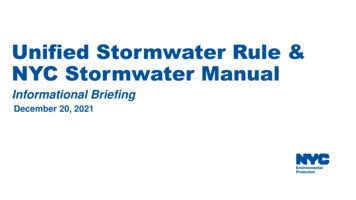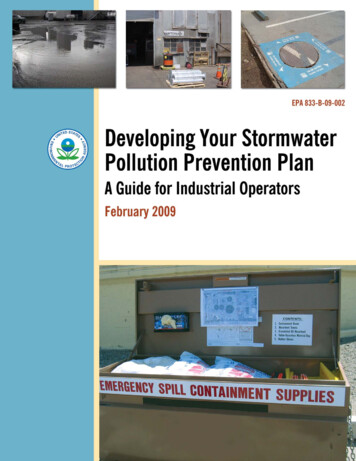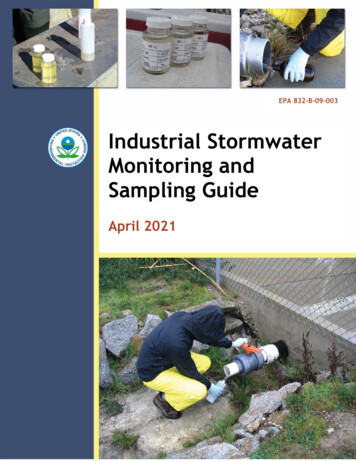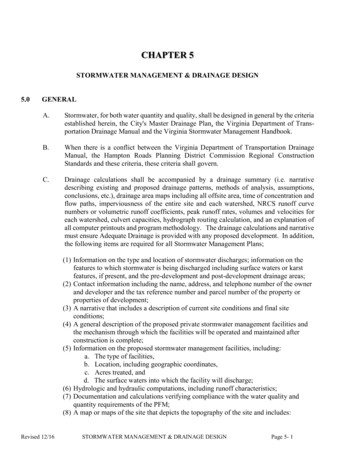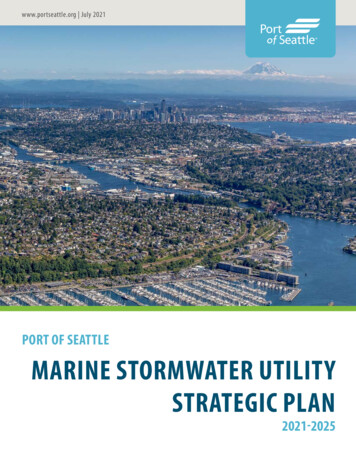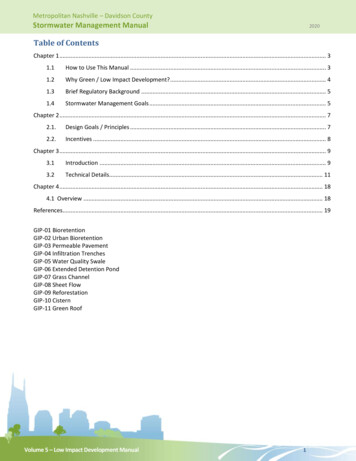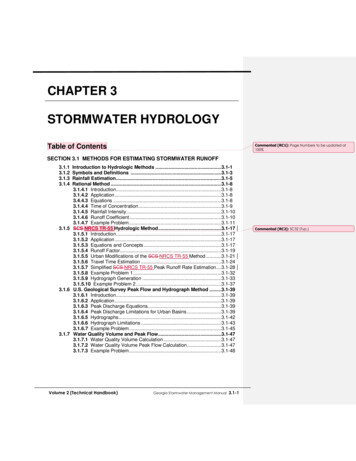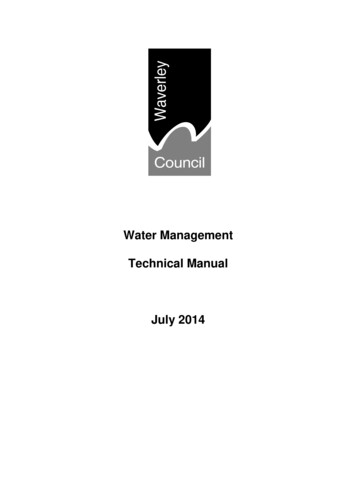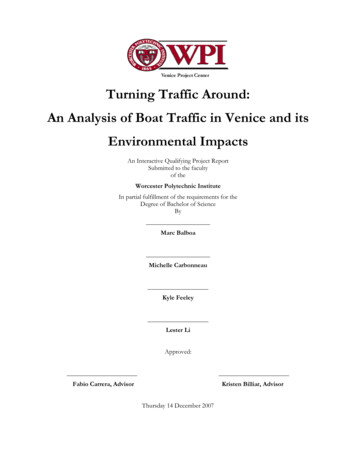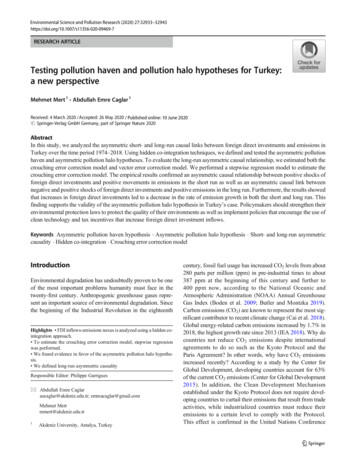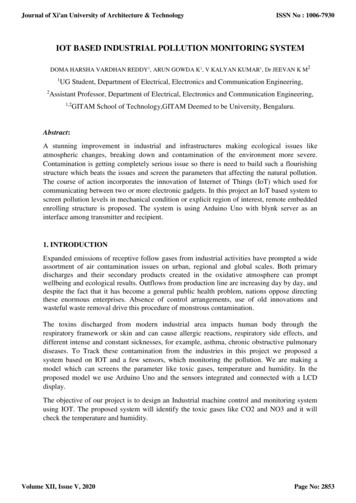
Transcription
Stormwater PollutionPrevention Manual:Best Management Practices forCommercial, Multifamily andResidential PropertiesJuly 2021Department of Natural Resources and ParksWater and Land Resources DivisionStormwater Services SectionKing Street Center, KCS-NR-5600201 South Jackson Street, Suite 5600Seattle, WA 98104206-477-4800 TTY Relay: /sppm
Stormwater Pollution Prevention ManualForewordThe King County Stormwater Pollution Prevention Manual (SPPM) was developed to complywith requirements of the Federal Clean Water Act–National Pollutant DischargeElimination System (NPDES) Program and the State Puget Sound Water QualityManagement Plan–Stormwater Program. The intent of these programs is to maintain andimprove the quality and beneficial uses of our water resources. The widespreadimplementation of best management practices (BMPs) is regarded as one of the bestsolutions to achieving this goal. This manual provides detailed information for businesses,residents, managers, and owners of property in unincorporated King County, and describesthe actions we are all required to take to reduce the contamination of stormwater, surfacewater (e.g., streams and lakes), and groundwater.Note: This manual replaces the King County Stormwater Pollution Prevention Manual, BestManagement Practices for Businesses, dated April 2016.AcknowledgementsPrimary Contributing Staff:Bob Bernhard, Source Control Program Manager (2021-present)Cynthia Hickey, Source Control Program Manager (2009-2021)Alison Schweitzer, Program/Project ManagerThe authors would like to thank David Batts, Cameron Chapman, Jeanne Dorn, MarilynGuthrie, Abby Hawley, Lou Leet, Edward McFarlin, Doug Navetski and Mark Wilgus fortheir valuable input.Clarification of ManualsThe Stormwater Pollution Prevention Manual (www.kingcounty.gov/sppm) presentspollution prevention practices for all property owners in unincorporated King County. Usethe King County Surface Water Design Manual (www.kingcounty.gov/swdm) forconstruction projects that require King County permits and have stormwater quantity andquality control requirements. Redevelopment or property improvements on existing sitesmay require structural BMPs. Structural BMPs are found in this manual as well as theKCSWDM.King County Stormwater ServicesiJuly 2021
Stormwater Pollution Prevention ManualTable of Overview . 1About This Manual. 1Best Management Practices (BMPs) . 1Exemptions . 2Step by Step Approach . 2Activities That May Result in Structural Improvements . 4Other Agency Requirements. 6Your Stormwater Drainage System . 7Stormwater problems . 9Stormwater Runoff . 9Storm Drains That Lead to Lakes and Streams . 9Polluting is Against the Law. 9Ways You May Be Polluting . 9Pollutants .102.5.1Oils, Greases, and Fuels.102.5.4Oxygen–Demanding Substances .112.5.22.5.32.5.52.5.63.02.5.72.5.83.13.2Metals .10Sediments.10Nutrients.11Toxic Organic Compounds.11Fecal Bacteria .12pH .12Commercial and Multifamily BMPs .13Pollution Prevention Practices .13BMP Activity Sheets .16A-1:A-2:A-3:A-4:A-5:A-6:A-7:Required BMPs for All Properties with Commercial Activities . 17Outdoor Storage of Liquid Materials in Stationary Tanks . 19Storage of Liquid Materials in Portable Containers . 21Outdoor Storage of Soil, Sand, and Other Erodible Materials . 23Storage and Use of Pesticides and Fertilizers. 25Storage of Contaminated Soils. 31Food and Beverage Manufacturing and Storage . 32King County Stormwater ServicesiiJuly 2021
Stormwater Pollution Prevention 7:A-48:A-49:Storage of Solid Waste and Food Wastes (Including Cooking Grease) . 35Storage of Scrap and Recycling Materials (Including Auto RecyclingFacilities) . 37Treatment, Storage or Disposal of Dangerous Wastes . 39Cleaning or Washing of Tools and Equipment . 40Cleaning of Washing of Food Service Areas and Equipment . 42Vehicle Washing and Steam Cleaning . 43Interior Washing Operations (Including Mobile Contractors) . 45Washing of Buildings, Rooftops, and Other Large Surfaces . 46Truck or Rail Loading and Unloading of Liquid or Solid Material . 48Stationary Fueling Operations. 49Vehicle and Equipment Repair and Maintenance . 53Concrete and Asphalt Production and Recycling . 55Concrete and Asphalt Application. 57Manufacturing and Post-Processing of Metal Products . 59Painting, Finishing, and Coating of Vehicles, Products and Equipment . 61Wood Treatment and Preserving . 63Commercial Composting. 64Chemical Applications – Other Than Landscaping . 66Landscaping Activities, Vegetation Management, and Irrigation . 68Clearing and Grading of Land for Small Construction Projects . 73Demolition of Buildings . 74Building Repair, Remodeling and Construction . 76Marine Activities . 78Parking Lots, Driveways and Outside Storage Areas. 85Sidewalk Maintenance . 87Swimming Pool and Spa Cleaning and Maintenance . 88Animal Waste . 90Keeping Livestock in Stables, Pens, Pastures or Fields. 92Logging and Log Yards . 95Mining and Quarrying of Sand, Gravel, and Other Materials . 96Well, Utility, Directional and Geotechnical Drilling. 97Roof Vents and Fugitive Emissions . 99Street Deicing Operations . 101Wheel Wash and Tire Bath Track Out Control . 102Potable Water Line Flushing, Water Tank Maintenance and HydrantTesting . 103Dust Control for Commercial Operations. 105Maintenance of Public and Private Utility Corridors and Facilities . 107Color Events. 109Older Stationary Fueling Operations . 112Mobile Fueling of Vehicles and Heavy Equipment . 116Nurseries and Greenhouses . 119Residential (Non-Commercial) BMPs . 122R-1:Residential Automobile and Boat Washing . 123King County Stormwater ServicesiiiJuly 2021
Stormwater Pollution Prevention ManualR-2:R-3:R-4:R-5:R-6:R-7:R-8:R-9:Residential Storage of Solid Waste and Food Wastes (Garbage) . 125Residential Vehicle Repair and Maintenance . 126Residential Hazardous Waste Use, Storage and Disposal . 127Residential Gardening, Lawn Care, Irrigation and FertilizerApplication . . 128Residential Home Maintenance and Repair . 130Residential Swimming Pool and Hot Tub Maintenance . 132Residential Animal Waste . 134Residential Dock Washing. 1375.0Information Sheets . 1406.0Technical Assistance. 1736.16.26.36.46.56.66.76.8Catch Basin Inserts . 141Containment. 145Controlling and Collecting Contaminated Runoff . 148Covering. . 151Disposal. 153Drainage Maintenance Contractors . 157Oil/Water Separator . 162Spill Response and Cleanup Plan . 164Water Quality Treatment BMPs . 170General BMP Selection . 173Sanitary Sewer and Septic Systems Resources . 174Waste Management and Recycling. 174Land Use, Fire Code, and Building Code Requirements . 177Erosion Control Practices . 177Air Quality . 178Environmental Organizations . 179Quick Phone References . 180King County Stormwater ServicesivJuly 2021
Stormwater Pollution Prevention Manual1.01.1OVERVIEWAbout This ManualKing County’s water resources – its streams, lakes, wetlands, groundwater, and PugetSound – play an important role in the quality of life we enjoy. They provide us withrecreation and drinking water, support tourism, salmon and multiple other fish species,and are used extensively in industry. These waters, however, are vulnerable to pollutionfrom a wide variety of human activities.Many of our water pollution problems are due in large part to pollutants washed off of landby storms. The quality of “stormwater” from residential properties, public facilities,commercial and industrial businesses, and agricultural lands is an increasing concernnationwide. The amount of pollution from any one place may not be significant by itself, butcumulative effects to water quality can be significant.The federal Clean Water Act mandates that cities and counties control the quality ofstormwater runoff through implementation of pollution prevention measures. To meet therequirements of the Clean Water Act and to sustain our quality of life, the King CountyCouncil passed King County Water Quality Code (KCC 9.12) in November 1992.This manual applies to all activities in unincorporated King County that have the potentialto contribute pollutants to stormwater runoff or to receiving waters directly. Stormwaterrunoff may seep into the ground, drain to a storm drain or a drainage ditch, or flow over theground. Regardless of the way runoff leaves the site, it can end up in a stream, river, lake,wetland, groundwater, or Puget Sound.King County Water Quality Code (KCC 9.12) requires the use of best management practices(BMPs) described in this manual. The manual includes: 1.2Stormwater BMPs for commercial, industrial, public, and multifamily residentialactivities (Chapter 3).Stormwater BMPs for single family residential properties (Chapter 4).Information on how to implement many stormwater BMPs (Chapter 5).Additional resources (Chapter 6)Best Management Practices (BMPs)The methods of protecting the quality of stormwater, surface water (e.g., streams andlakes) and groundwater, are called best management practices (BMPs). BMPs encompass avariety of managerial, operational, and structural measures that will reduce the amount ofcontaminants in stormwater and improve the quality of our water resources.King County Stormwater Services1July 2021
Stormwater Pollution Prevention ManualBMPs are separated into two broad categories: source control and treatment. Sourcecontrol BMPs prevent contaminants from entering water bodies or stormwater runoff.Some source control BMPs are operational, such as checking regularly for leaks and dripsfrom equipment or vehicles, covering materials that have the potential to add pollutants tosurface water, and educating employees about site clean–up procedures. Other sourcecontrol BMPs are structural, including roofs, berms, and fueling pads.Treatment BMPs are activities that treat stormwater to remove pollutants although notreatment BMP can remove 100 percent of the contaminants.It is more efficient, effective, and economical to prevent the contamination of stormwaterthan to treat it.1.3ExemptionsYou are exempt from implementing equivalent BMPs in this manual if you: Have obtained and are complying with a permit under the National PollutantDischarge Elimination System (NPDES) Stormwater Permit Program.Implement and maintain a farm management plan developed by the KingConservation District (KCD) and approved by King County Department of NaturalResources and Parks.Implement BMPs in compliance with KCC 21A.30, which addresses animal andlivestock keeping practices.Engage in forest practices, with the exception of Class IV general forest practices.These exemptions are only from the requirements of this manual. If you are exempted forone or more of the reasons listed above, King County assumes that you are implementingthe appropriate BMPs. If you have not implemented BMPs, or they are not effectivelyaddressing the discharge of contaminants, then you will be required to comply with thismanual. The following is a step–by–step approach to BMP compliance.1.4Step by Step Approach1. Determine Your Status - If you are not exempt due to an above listed reason, thenyou must comply with the BMPs in this manual.2. Evaluate Existing Conditions - Determine which activities in this manual areapplicable to your property using the BMP Identification Worksheet. Review theapplicable BMP activity sheets which can be found in Chapter 3 of this manual andon our website at www.kingcounty.gov/sppm.You will need to be familiar with the stormwater drainage system on your site.3. Seek Assistance - You can have a free on–site consultation with a staff memberfrom King County Stormwater Services who will walk through your site, discussconditions and necessary BMPs, and provide assistance with implementation. ToKing County Stormwater Services2July 2021
Stormwater Pollution Prevention Manual4.5.6.7.8.request an on–site consultation, call King County Stormwater Services at 206–477–4811.Check Your Internal Floor Drains and Plumbing System Connections Discharges from internal floor drains, appliances, industrial processes, and sinksand toilets that are connected to the nearby stormwater drainage system can causesignificant stormwater pollution. These discharges must go to the sanitary sewersystem, a holding tank, an on–site process water treatment system or a septicsystem.For information on how to check for illicit connections refer to BMP activity sheet A1: Required BMPs for All Properties with Commercial Activities. You can also gethelp from your local sewer utility. If you find out that your internal drains areimproperly connected to the stormwater drainage system, they will need to beremoved, permanently plugged, or connected to the sanitary sewer, septic system,on–site treatment system under certain conditions, or a holding tank.Note: Only residential strength wastewater (or domestic wastewater) from sinks,toilets, washing machines, dishwashers, bathtubs, and showers can legally bedischarged to a septic system. Non–domestic wastewater (or commercial, industrial, ornon–residential wastewater) should never enter the septic system; it cannot betreated. Non–domestic wastewater may also kill beneficial microorganisms that treatsewage, and can contaminate soil and groundwater. Only put things down the drainthat the septic system is designed to handle organic waste and septic system friendlypaper products. Floor drains directly connected to septic systems may pose health andfire hazards due to septic gases.Develop and Implementation Strategy - Look at the property as a whole todetermine how the BMPs you implement will work together. There may beacceptable BMPs that are not listed in the manual. Be creative in assessing your ownneeds and the constraints that you may face on your property.Implement the Nonstructural Source Control BMPs - First, implement the BMPsthat do not require extensive construction. Examples include having spill controland cleanup materials on site, using drip pans or drop cloths when conducting dayto day activities, and sweeping instead of hosing down an area to a storm drain.Implement Structural Control BMPs if Necessary - Second, implement thestructural source control BMPs that may require a building permit or require largercapital expenditures. Examples include constructing a building to enclose a workactivity that is currently in the open, or building a containment area.Implement a Treatment BMP - If a treatment BMP is determined to be necessaryfor your site, you must have an acceptable design prepared and approved by KingCounty Water and Land Resources Division (WLRD). You may be required to use theKing County Surface Water Design Manual (KCSWDM) when designing and receivingapproval of treatment BMPs. Once the design has been approved by WLRD and apermit issued (if necessary) from the King County Department of Local Services,Permitting Division (Permitting), construction may begin.King County Stormwater Services3July 2021
Stormwater Pollution Prevention Manual9. Keep Records - Keep copies of the activity sheets and other documentation onimplementing BMPs. Records may be used to illustrate compliance with this manual.10. Maintain Your BMPs - Business owners and property managers must ensureemployees are maintaining all applicable BMPs in Chapter 3. Employee educationshould be a continuous process for effective BMP implementation. Single familyresidential properties are also required to maintain all applicable BMPs in Chapter4.1.5Activities That May Result in StructuralImprovementsThere are a number of activities that may require structures and/or specific drainageconfigurations in order to protect stormwater and maintain compliance with King CountyWater Quality Code 9.12. Roof structures, wheel washes, cement pads, shutoff valves,containment berms and indoor mop sinks are all examples of things that need to be in placeprior to commencing the activity. These may require building permits and other approvalsprior to construction. For information contact Permitting at 206-296-6600 orDPERWebInquiries@kingcounty.gov.Below are some highlighted activities and BMP activity sheets that provide more detail:Commercial CompostingStructural improvements: paved composting and storage pads, leachate collection system,lined collection ponds, contaminated stormwater collection and treatment, and wheel washsystem BMP activity sheet A-24: Commercial CompostingFood and Beverage Manufacturing and StorageStructural improvements: roofed enclosures, containment, wastewater collection, storage,and disposal system BMP activity sheet A-7: Food and Beverage Manufacturing and StorageFueling of equipment and vehiclesStructural improvements: Portland cement pads, roofs, spill control devices, trench drains,and oil/water separators BMP activity sheet A-17: Stationary Fueling Operations BMP activity sheet A-47: Older Stationary Fueling OperationsGreenhouses and plant nurseriesStructural improvements: berms, covering and erosion control measures BMP activity sheet A-4: Outdoor Storage of Soil, Sand and Other Erodible Materials BMP activity sheet A-49: Nurseries and GreenhousesKing County Stormwater Services4July 2021
Stormwater Pollution Prevention ManualHorse stablesStructural improvements: wash racks connected to sanitary sewer or separate infiltrationarea, and manure containment areas BMP activity sheet A- 35: Keeping Livestock in Stables, Pens, Pastures or FieldsMining of sand or gravelStructural improvements: wheel wash system and track–out control, and catch basininserts BMP activity sheet A-41: Wheel Wash and Tire Bath Track Out ControlOutdoor storage of erodible materials (e.g. compost, bark, sand)Structural improvements: wheel wash system and track–out control, berms, containmentareas, covering, paving, catch basin inserts, and treatment systems BMP activity sheet A-41: Wheel Wash and Tire Bath Track Out ControlOutdoor storage or processing of galvanized materialsStructural improvements: roofs or other covering, and stormwater collection andtreatment system BMP activity sheet A-21: Manufacturing and Post–Processing of Metal ProductsPainting, Finishing and Coating of Vehicles and EquipmentStructural improvements: permitted and enclosed paint booths BMP activity sheet A-22: Painting, Finishing and Coating of Vehicles, Products, andEquipmentRestaurants and food trucksStructural improvements: indoor sinks for mat and rack washing, and mop and wastewaterdisposal BMP activity sheet A-8: Storage of Solid and Food Wastes (Including CookingGrease) BMP activity sheet A-12: Cleaning or Washing of Food Service Areas and EquipmentStorage of liquid materialsStructural improvements: secondary containment, roofed structures, and spill controldevices BMP activity sheet A-2: Storage of Liquid Materials in Stationary Tanks BMP activity sheet A-3: Storage of Any Liquid Materials in Portable ContainersUtility Corridor MaintenanceStructural improvements: road stabilization BMP activity sheet A-45: Maintenance of Public and Private Utility Corridors andFacilitiesKing County Stormwater Services5July 2021
Stormwater Pollution Prevention ManualWashing of cars, trucks, and equipment (not just commercial car washes)Structural improvements: dedicated wash pads, sewer connection, holding tanks and catchbasin inserts BMP activity sheet A-11: Cleaning or Washing of Tools and Equipment BMP activity sheet A-13: Vehicle Washing and Steam CleaningWood Treatment & PreservingStructural improvements: paved, contained, and covered storage and processing areas BMP activity sheet A-23: Wood Treatment and Preserving1.6Other Agency RequirementsPlease note that other federal, state, and local agencies enforce regulations that may relateto your implementation of BMPs. Consult the following entities for guidance on the listedactivities:King County Surface Water Design Manual Drainage requirements, and construction BMPs for erosion and sediment control fornew development and redevelopmentKing County Critical Areas and Clearing and Grading Ordinances Land use regulations protecting environmentally sensitive areas and public healthand safetyKing County Fire Code Storage and handling of flammable, combustible, and hazardous materialsKing County Animal Regulations (Livestock Ordinance) Raising and keeping of livestockKing County Wastewater Treatment Division - Industrial Waste Section, and LocalSewer Authorities Acceptance of process water or contaminated stormwater to sanitary sewersKing County Solid Waste Division – Hazardous Waste Management Program Acceptance of household hazardous waste from residents and qualifying smallquantity generatorsPublic Health – Seattle and King County Solid wasteKing County Stormwater Services6July 2021
Stormwater Pollution Prevention Manual Septic systems (on–site septic systems)Structural pesticide applicatorsWashington State Department of Ecology National Pollutant Discharge Elimination System (NPDES) permits Discharge of process wastewater to surface waterUnderground storage tanksSpill prevention and control plansDangerous waste generatorsGroundwater quality protectionOil spill prevention and cleanup plans (with U.S. Environmental Protection Agency)Washington State Department of Agriculture Pesticide applications Nutrient management plansPuget Sound Clean Air Agency Fugitive dust Outside paintingSpray boothsU.S. Coast Guard Transfer of petroleum products on Puget Sound1.7Your Stormwater Drainage SystemIf you have a set of plans/blueprints of your site and the associated stormwater drainagesystem, familiarize yourself and your employees with drainage patterns and drainagestructure location. If you do NOT have a set of plans for the property, prepare a roughsketch to familiarize yourself and your employees with your on–site stormwater drainagesystem to aid in the implementa
Management Plan-Stormwater Program. The intent of these programs is to maintain and improve the quality and beneficial uses of our water resources. The widespread implementation of best management practices (BMPs) is regarded as one of the best solutions to achieving this goal. This manual provides detailed information for businesses,
